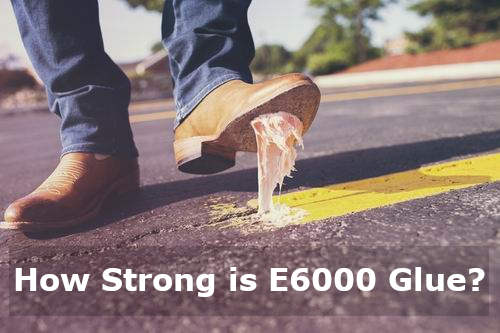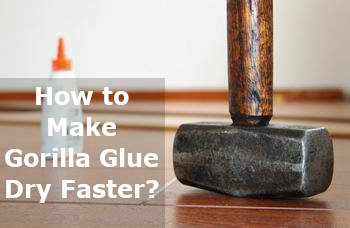
Are you making unique jewelry? Attaching binding to glass pendants might be a challenging task. Therefore, you would consider using E6000 adhesive. It’s recommended to jewelry makers, householders and artists. However, how strong is E6000? Before opting for one of these top-quality products, you would evaluate their properties, health risks and versatility.
Table of Contents
How Well Does E6000 Hold?
E6000 is a well-known brand or line of top-quality products. All of them are described as industrial-strength adhesives. They are multi-purpose, suitable to be used as glue for glass to metal. They also provide perfect adhesion to other materials, including:
- wood;
- ceramics;
- fiberglass;
- rubber;
- leather;
- concrete.
These glues are solvent-based, evolving potentially toxic fumes, difficult to remove from your skin and various surfaces.
Are there any differences? It might be only in the ratio of ingredients. Being commonly based on perchloroethylene, these adhesives are non-flammable, but volatile and highly-stable. However, as the adhesives’ composition is kept secret, let’s consider their characteristics.
Properties of Adhesives
| E6000 Product | Size, fl. oz | Tensile Strength, lb/in2 | Density, lbs/gal | Tack time, min | Elongation, % |
|---|---|---|---|---|---|
| Craft | 0.18 | 3500 | 11 | 4 | 900 |
| Industrial | 3.7 | 3500 | 11 | 4 | 900 |
| Plus | 1.9 | - | 8.95 | 30-35 | 325 |
| Jewelry&Bead | 1 | 3500 | 2.1 | 4 | 900 |
So, what is the strongest type of glue? E6000 industrial is promoted as a very tough glue. It’s specified to be 2 times stronger than a polyurethane glue, such as Original Gorilla adhesive. Do other E6000 products differ a lot? Basic difference seems to be only in size that is in tube capacity.
Is E6000 Stronger than Epoxy?
Quite naturally, E6000 Plus differs by composition from the other products from this range. I’m sure it’s less strong than the basic items. Its hardness is 25 Shore A, while industrial glue is specified as 80 (Shore A). It can be compared with hardness of rubber band.
However, it’s solvent-free, non-toxic. Quite naturally, it’s much safer if you use it indoors. I think it’s the best glue for glass, as it’s:
- crystal clear;
- flexible;
- paintable;
- self-leveling.
Therefore, initiating a DIY or craft project, I would use this type of adhesive. Quite naturally, if tensile strength is not critical. So, is e6000 stronger than Gorilla Glue? It’s similar to polyurethane adhesives as they might withstand up to 8MPa (about 1160 PSI(lb/in2)).
As to epoxy adhesives, they are known to be super strong. Their resistance to loads or stress is up to 35-40 MPa. High-temperature materials that are used in aerospace industry, are even more durable. However, what about Epoxy Stick adhesive from Gorilla range? Its strength is specified as 1550 PSI that is about 10.78 MPa. So, it’s stronger than the glues than show 8MPa but worse than E6000 adhesives.
How Long Does Gorilla Glue Epoxy Take to?
Taking into account drying time, Gorilla adhesive materials are beneficial. They are:
- fast-setting;
- tough;
- versatile;
- moisture and heat resistant.
How Long Does Gorilla Glue Take to Set?
| Type of Gorilla Glue | Drying Time | Time to Set, hr. |
|---|---|---|
| Original | 10-30 sec. | 24 |
| Super | 5-15 sec. | 8-24 |
| Epoxy | 10 min. | 24-48 |
Difference is significant, as Original Gorilla adhesive is based on a polyurethane formula. Super Glue is cyanoacrylate. Both are water-based, comparatively non-toxic, and suitable to bond various surfaces. So, each of them is recommended as a glue for glass to glass.
Meanwhile, most of E6000 adhesives set within 20 minutes. Cure time is up to 72 hours if the film is thick. Meanwhile, these adhesive materials have some significant benefits. They are preferable for outdoor applications, as the glues are UV-resistant, flexible, stable at freezing temperatures.
How Long Does E6000 Last?
Long shelf life is another great advantage of the brand. Thus, if you haven’t opened the tube, Craft, Industrial Jewelry&Bead products remain applicable for 2 long years. E6000 Plus is stored for not longer than a year. Shelf life of Gorilla adhesives is about 3 years if the bottle remains sealed. Perhaps, the formula matters. Upon being dampened, Gorilla materials are activated by water. Before this chemical reaction, they are safe and neutral.
Do you mean the bond durability? It depends on multiple factors, such as film thickness, materials to attach and environment that is temperature and humidity. Adhesion test shows various results on:
- aluminum;
- steel;
- wood;
- glass;
- PVC.
A bond that connects 2 glass surfaces is a bit less strong than if you attach metal or wood. According to ASTM D 903, it withstands load up to 34 pounds/linear inch. Meanwhile, does hot glue work on glass? Thermoplastic adhesive that is commonly applied by a glue gun is heated and melted. It has strong bonding properties.
However, it doesn’t stick to surfaces that are wet, oily or greasy. Glass surface is too smooth to apply the material. It goes hard and comes unstuck. So, it just slips as adhesion is not efficient.
What Type of Glue to Use on Glass?
Silicone adhesives are a good choice. They might become soft or hard upon curing. However, flexible ones work well. Prefer a glue with high elongation properties, such as:
- E6000 (tetrachloroethylene-based).
- Polyurethane (Original Gorilla).
- Silicone.
Silicone adhesives, like Permatex-branded, are applied as automotive windshield sealants. They are tough, waterproof and durable, withstanding vibration and extreme temperatures.
Does Gorilla Glue work on glass? Standing by terrific flexibility, Original Gorilla adhesive is suitable even to attach large glass surfaces. Elongation of water-cured polyurethane glues is up to 600%. It expands 3 times, becoming strong and waterproof.
On the contrary, Epoxy and Super glues that are poor in terms of elongation are good to glue only small glass items. Thin film is reliable, but on large smooth surfaces, a bond of this kind would be weak.
How Do You Glue Something to Glass?
Smooth surfaces are tricky to attach. To glue them perfectly well:
- clean both pieces of bowl or plate;
- apply the adhesive;
- press the items together;
- let the glue set;
- in 24 hours remove excess material.
Clamping could be required, when it goes about large, smooth surfaces. Meanwhile, don’t forget to wear a facemask and protective gloves, ventilate the room. Avoid inhaling toxic fumes. Don’t let the glue stick to your fingers.
How do you think now, what is the best glue for glass? Several E6000 products suit this application very good. They are strong, durable and flexible. Additionally, these adhesives are transparent, suiting multiple craft and household applications.
Glue e6000 vs Gorilla Glue
Gorilla Glue and E6000 have slightly different properties when bonding materials:
Properties Glue E6000
- Flexible – Elastic formula works well even on flexible surfaces
- Transparent finish – Bonds dry mostly clear for low visibility
- Resists humidity and water
- Long working time – Reposition bonds up to 1 hour after applying
Properties Gorilla Glue
- Rigid tough finish – Holds up to drops, hits, weight better
- Foams as it dries which helps fill gaps
- Bonds fast for quick repairs
- Works well on porous materials like wood
- Water resistant when cured
For metal, glass, and plastic Gorilla Glue can become brittle over time. E6000 maintains some flexibility. However Gorilla Glue is less messy to work with and dries rigid.
So E6000 is better for gluing dissimilar materials like bonding metal to fabric. It flexes without cracking. Gorilla works very well gluing wood together due to its expanding foamy finish filling pores.
Choose based on the substrates, flexibility needed, working style and environmental factors like humidity and expected impacts. Both make strong versatile household glues.
B7000 vs E6000: Which glue is better?
Ever wondered which glue is the superhero of the adhesive world – B7000 or E6000? Let’s uncover their strengths and weaknesses to see which one emerges as the glue champion!
Both B7000 and E6000 are powerful adhesives known for their versatility and strength. They’re like the heavyweight contenders in the world of glues, each with its unique set of qualities.
Let’s start with E6000 – it’s like the tough and resilient glue. This adhesive is known for its incredible strength, flexibility, and durability once it sets. It works well on a variety of surfaces like metals, plastics, glass, and even fabrics. It’s a go-to choice for projects that need a strong bond and can withstand temperature fluctuations.
On the other hand, B7000 is like the precision artist of glues. It’s known for its fine detail work and ability to bond delicate materials like rhinestones, beads, or phone repairs. While it’s strong and flexible, it might not have the same heavy-duty strength as E6000.
When choosing between the two, consider the specific needs of your project. If you’re working on something that requires heavy-duty strength and resilience, E6000 might be the winner. But if you’re doing intricate crafts or repairs that need precision bonding, B7000 could be your go-to adhesive.
However, it’s essential to note that both glues contain chemicals, so it’s crucial to use them in a well-ventilated area and follow safety precautions.
In summary
E6000 excels in strong bonding for various surfaces and durability, while B7000 shines in precision bonding for delicate projects. Choosing the best glue depends on your specific project needs. So, whether you need a tough warrior or a delicate artist, both B7000 and E6000 have their strengths in the world of adhesives!






I build rock sculptures, I am presently using the Gorilla epoxy glue. However if does not the mixture of glue and hardener just right, the curing is incomplete and structures will fail. Can you recommend a better glue ? I do use re-enforcing rods, the glue.
How would E 6000 work ?
Hi Peter,
Of course, I did not glue the stone sculptures. Basically I glued little things, usually glass.
In my opinion, stone and glass are similar in adhesion or penetration of glue into them.
You can try this sample.